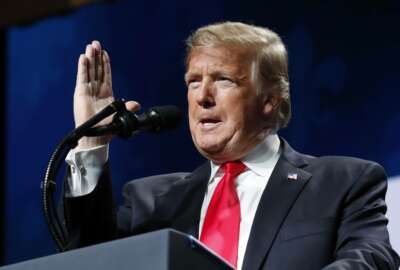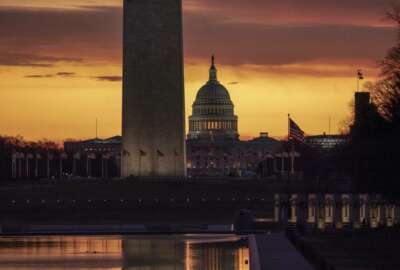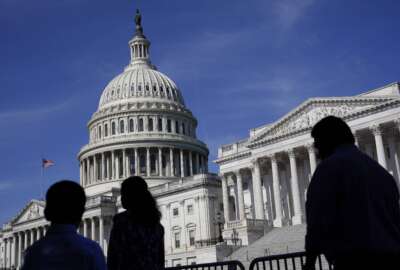Hubbard Radio Washington DC, LLC. All rights reserved. This website is not intended for users located within the European Economic Area.
What happens to furloughed employees during a government shutdown?
During the last government shutdown in 2018 and 2019, roughly 800,000 of the 2.1 million civilian federal employees at the time were furloughed.
Up to 2.2 million civilian federal employees face the possibility of either a furlough or work without pay, as Congress has just days to reach an agreement on federal spending before a government shutdown kicks in.
During a government shutdown, agencies that don’t yet have their funding determined by Congress are legally required to shutter all activities that are financed by appropriations.
That means many federal employees are placed on a “shutdown furlough,” and have to cease work and temporarily go without pay. During the last government shutdown, roughly 800,000 of the 2.1 million civilian federal employees at the time were furloughed. Employees who agencies determine are needed to conduct excepted activities continue to work during a shutdown without pay. Agencies are responsible for notifying employees of a furlough as soon as possible.
“Typically, an agency will have very little to no lead time to plan and implement a shutdown furlough,” the Office of Personnel Management states on its website.
Agencies are required to create contingency plans in the case of a government shutdown. The Office of Management and Budget regularly updates a running list of these plans.
But many of the plans aren’t up to date. Several are from 2019, and a few date back as far as 2015. Some agencies, including the departments of Defense, Energy and Housing and Urban Development (HUD), as well as NASA and the Social Security Administration, updated their plans earlier this year, though.
How pay works during a shutdown
Among these contingency plans, there are also near-countless questions on how exactly a shutdown impacts furloughed employees. Top of mind, of course, is pay. During a shutdown, furloughed employees do not work and do not receive pay — but they will receive backpay after a shutdown ends.
In past government shutdowns, federal employees have always eventually received backpay. But backpay was not fully guaranteed until 2019. If there is a shutdown this year, it would be the first time all federal employees are firmly guaranteed backpay.
The Government Employee Fair Treatment Act, which former President Donald Trump signed into law, covers both furloughed and excepted federal employees. It ensures they’ll receive retroactive pay during lapses in appropriations once a shutdown ends.
Employees who are excepted and continue to work through a government shutdown are entitled to their standard pay and are eligible for premium pay if they work overtime, once the shutdown ends.
Additionally, if a shutdown occurs in the middle of a pay period, furloughed employees should still receive paychecks on time for work they did prior to the start of the shutdown, OPM said in 2021 shutdown guidance.
For the tens of thousands of federal contractors who may get furloughed during a government shutdown, backpay is not guaranteed. In these instances, it’s up to the individual company to determine whether the employees will be reimbursed after a shutdown ends.
Paid leave and federal health insurance
When it comes to paid leave, agencies are required to cancel paid time off that furloughed employees may have scheduled during a shutdown. A furloughed employee may not use previously approved paid time off during a lapse in appropriations. But shutdowns don’t affect the accrual of paid leave or sick leave, which can be used after the end of a shutdown.
Excepted employees who continue to work and who want to use paid leave during a shutdown will receive pay for that leave under the normal leave rules once the lapse ends, OPM said.
Health insurance coverage also continues during a shutdown for both furloughed and excepted employees. Agencies continue to process transactions for the Federal Employees Health Benefits (FEHB) program, the Federal Employee, Federal Employees Dental and Vision Insurance Program (FEDVIP), the Federal Long Term Care Insurance Program (FLTCIP) and the Federal Employees’ Group Life Insurance (FEGLI) during a lapse in appropriations, OPM said in its shutdown guidance.
But furloughed employees generally have to wait until the end of a shutdown before they can adjust their benefits. As an exception, feds will still be able to make changes to their enrollments during Open Season or if they experience a qualifying life event during a shutdown.
Health premium payments are also typically paused during a shutdown. After a shutdown ends, previously furloughed employees will begin repaying FEHB premiums that accumulated during the shutdown through payroll withholding.
Retirement services and the Thrift Savings Plan
Federal retirement services also continue during a government shutdown. Federal retirees will still receive their scheduled annuity payments, OPM said.
For those looking to retire from the government, services proceed as normal during a shutdown, although they may slow down. OPM’s Retirement Services staff continue work during a shutdown. Retiring feds will begin receiving interim annuity payments while their applications are processed, OPM said.
Operations for the Thrift Savings Plan and the Federal Retirement Thrift Investment Board are also largely unaffected by a government shutdown. That’s because the TSP is not funded through congressional appropriations.
TSP participants can still make contributions and withdrawals, apply for loans and take other actions as normal.
Lawmakers call shutdowns “unacceptable”
Despite the continuity of some federal operations, many lawmakers have said there are major deleterious effects of government shutdowns. Agencies cannot plan ahead and many services to the public are delayed or suspended. Some lawmakers are particularly concerned for the hundreds of thousands of potentially furloughed feds.
In response, a few lawmakers are trying to end government shutdowns once and for all. Sen. Tim Kaine (D-Va.) and Rep. Don Beyer (D-Va.) reintroduced the bicameral End Shutdowns Act earlier this month. The bill would automatically kick in a continuing resolution on Oct. 1 if Congress can’t reach an agreement on appropriations, in effect preventing either a full or partial shutdown of the government.
“Government shutdowns have disastrous consequences for federal employees and government contractors and slow down critical government services,” Kaine said in a press statement. “This is unacceptable.”
A couple lawmakers are also raising concerns about excepted feds who would continue to work during a shutdown. Reps. Gerry Connolly (D-Va.) and Derek Kilmer (D-Wash.) urged the Biden administration to work with agencies and ensure the continuity of federal child care options in the case of a shutdown.
“A government shutdown should not create a double burden for these employees, forcing them to choose between fulfilling their professional obligations and meeting the needs of their families,” Connolly and Kilmer said in a letter to OMB Tuesday. “The strain that this choice places on federal employees can have detrimental effects on their mental well-being, job performance and overall morale.”
Joining calls from several lawmakers, federal unions are also pushing Congress to pass a continuing resolution and avoid a government shutdown.
“During the last partial government shutdown, 800,000 federal employees went five weeks without a paycheck, with half forced to work without pay and another half locked out of their jobs,” American Federation of Government Employees National President Everett Kelley said in a statement Tuesday. “These costly outcomes are completely avoidable. Congress needs to do its job and pass a continuing resolution to keep the government funded at current levels while continuing to negotiate a final budget. Nothing less is acceptable.”
Copyright © 2024 Federal News Network. All rights reserved. This website is not intended for users located within the European Economic Area.
Drew Friedman
Drew Friedman is a workforce, pay and benefits reporter for Federal News Network.
Follow @dfriedmanWFED
Related Stories
Government shutdowns: Once ‘incomprehensible, inconceivable, unthinkable,’ now the norm
Related Stories
-
Trump signs bill ensuring federal employees get paid after government shutdown Government Shutdown





